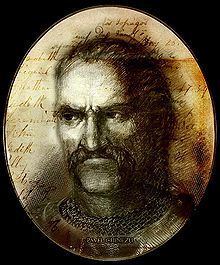Coat of arms Name Pal Kinizsi Religion Christian | Died 1494 Spouse(s) Benigna Magyar | |
 | ||
Occupation Hungarian magnate and general Memorials Statue in Budapest by Janos Pasztor (1930) | ||
The sound of hungarian pal kinizsi and matyas kiraly
Pál Kinizsi (1432–1494) was a Hungarian general in the service of king Matthias Corvinus. He was the Count of Temes from 1484 and Captain-General of the Lower Parts. He is famous for his victory over the Ottomans in the Battle of Breadfield in October 1479.
Contents
- The sound of hungarian pal kinizsi and matyas kiraly
- Origin and early life
- Military career
- Family
- Titles
- Folklore
- References
Origin and early life
Kinizsi's ancestry is obscure. According to some he was a son of a miller, and prior to his military career, he was a journeyman miller. According to some Hungarian, and Serbian historians, he was of Serbian origin, and was possibly a descendant of Vuk Branković, though this could not be determined.
Military career
His central estate was the Castle of Nagyvázsony.

After the death of king Matthias in 1490 he supported Polish (by birth) king Vladislas II of Hungary and the great magnates against Matthias' illegitimate son and designated successor John Corvinus. He destroyed the former king's mercenary Black Army which had become a robber band after its dissolution. He then was crippled by a stroke and died shortly afterwards.
Family
He married Benigna Magyar, the daughter of Blaise Magyar, another general of Corvinus. He had no known issue.
Titles
Folklore
In legends, he is known as a commoner. Kinizsi is a hero of some Hungarian and Romanian folk tales along with king Matthias Corvinus as an extremely strong former miller's apprentice. According to these tales, the king was hunting in the Bakony forest near the mill where he worked and asked for a drink; Kinizsi, to show his strength, served the cup on a millstone. The king, impressed, took him into his service, where Kinizsi's strength, prowess and loyalty earned him rapid promotion. He is said to have wielded two greatswords in battle and to have danced a victory dance after the Battle of Kenyérmező with a captured or dead Turk under each arm and a third held with his hair or belt in his teeth.
